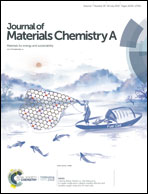High-rate capability and long-term cycling of self-assembled hierarchical Fe3O4/carbon hollow spheres through interfacial control†
Abstract
Nowadays it remains a big challenge to achieve high-rate capability and long-term cycling of metal oxide anodes for secondary batteries, due to large volumetric variation-induced unstable electrolyte–metal oxide interfaces. Here we demonstrate that three-layered Fe3O4/carbon hollow spheres with an electrical conductivity of (9.90 ± 0.14) × 10−2 S cm−1 self-assembled through an aerosol-pyrolysis strategy are very promising architectures to achieve long-term cycling at high current density for lithium-ion batteries. They can maintain a reversible capacity of 383 mA h g−1 after 1000 discharge/charge cycles without apparent capacity fading at a current density of 10 A g−1, which is higher than the theoretical capacity of a commercial graphite anode (372 mA h g−1). The nitrogen-doped carbon outer layer, the large-sized dense Fe3O4/carbon mid-layer and the small-sized Fe3O4/carbon inner layer provide fast electron/Li ion transport channels, a restriction “hoop” and buffer space for volumetric variation simultaneously, which enable a stable electrolyte–sphere interface during discharge/charge cycling. Furthermore, the hierarchical Fe3O4/carbon spheres can be facilely and continuously tuned from solid to porous, and then to a hollow structure. This reasonable design through an interfacial control strategy may open a way to synthesize other metal oxide/carbon porous/hollow spheres for energy-storage applications.



 Please wait while we load your content...
Please wait while we load your content...